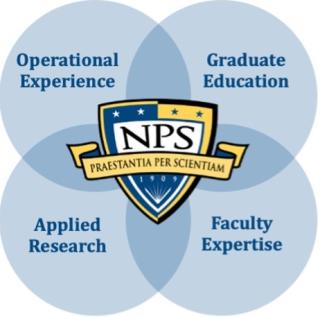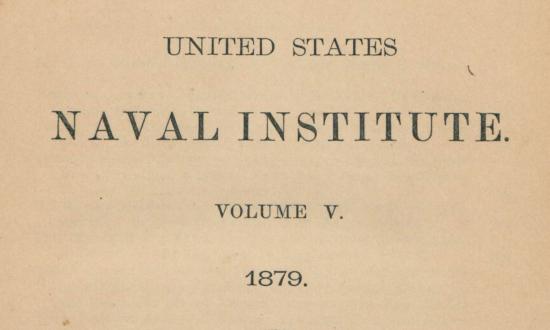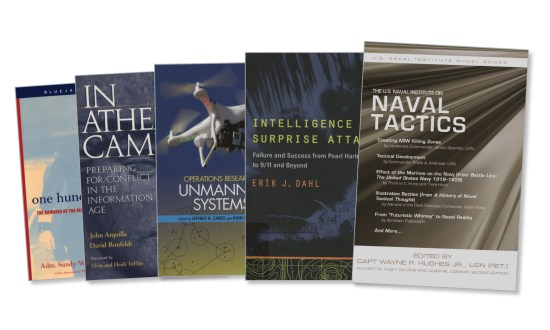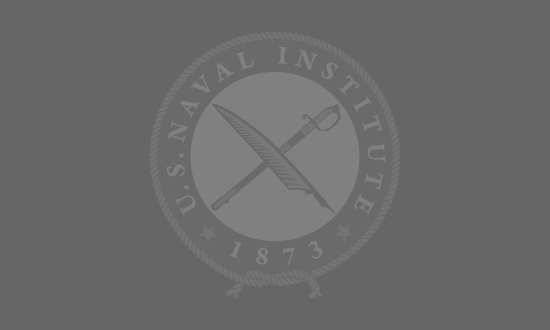We stand at a critical inflection point. U.S. national security must contend with increasing great power competition (GPC), which is fundamentally an innovation race—one well contested by our near-peer rivals. While technological change is inevitable, the rapidly emerging integration of computational power with its human masters, the so-called Cognitive Age is poised to create unprecedented national security challenges, and at a pace measured in months and not years.
More than just a strategic shift to global hegemonic powers, naval forces must be prepared to compete in the cognitive and conventional arenas: to outthink, outmaneuver, and outfight. To prevail, we must quickly secure technology advantages, as well as the cognitive agility to employ them effectively. This is technological leadership.
Falling behind is an existential risk. Preparing naval leaders for a maritime battlespace rapidly increasing in technical complexity requires integrating the latest science and technology (S&T) research quickly into naval S&T education to simultaneously accelerate solutions and develop leaders with the knowhow to use them. Developing intellectual capital is a critical component of the GPC innovation race.
Education is as vital to seapower as platforms and weapons systems. This was the conclusion of the Education for Seapower report published in December 2018, which remains a solid foundation on which to build. The new tri-service maritime strategy, Advantage at Sea, goes further, calling on the Navy, Marine Corps, and Coast Guard to prioritize training and education as the first of six lines of effort to create an integrated, all-domain naval force.
For its part, the Department of the Navy (DoN) launched the U.S. Naval Community College, revised Navy and Marine Corps personnel evaluation systems to include education as a promotion criterion, and gave OPNAV N7 oversight of a new Naval Education Enterprise (NEE).1 The DoN has already taken significant steps to align education and research for seapower within the NEE. These successes must not be end points, but rather building blocks toward a more agile and adaptive tri-service maritime fighting force.
How then do we continue this vital work of accelerating our technological and intellectual advantage at sea? The answer is to fully synchronize advanced naval science, technology, engineering, and math (STEM) education with research in emerging technologies. Tighter coupling of naval research with graduate education will focus, enhance, and accelerate development and delivery of technology applications—from management to warfighting—shaping the future while enhancing the ability of our warriors to use these technologies across the all-domain maritime battlespace.
Naval research and education each temper the other’s steel—together they forge superior technology and intellectual prowess to create the cutting edge of decisive capability.
Research + Education = Capability
The bottom line is simple: whoever innovates effectively the fastest wins. This is a technical and intellectual race.
Already, the Naval Research Enterprise (NRE), led by the Office of Naval Research (ONR), is demonstrating ever greater agility by accelerating the transformation of research programs to operational results. Research enables technology and provides a hedge against uncertainty.
Yet, technology alone does not assure victory. Superior technology must be combined with the critical thinking of well-educated officers at every echelon to explore new concepts and employ technology to create the decisive edge. Education enables leaders to identify and navigate uncertainty.
Prevailing in great power competition requires the full integration of research and education for advantage at sea. The fact that the Naval Postgraduate School (NPS) is now a chartered member of the Naval R&D Establishment (NR&DE) is testimony to the importance of this partnership.2 Building on our history of collaboration in research and education will accelerate naval innovation and capability: R + E = C.
Naval Education: Our Cognitive Advantage
Opportunities for innovation abound in every age of acceleration. However, new technology without the intellectual pursuit of education to recognize, analyze, and employ research solutions is the equivalent of a technological edge without a cognitive whetstone.
Take the case of Lieutenant William Sims, a mid-career officer who, at the turn of the nineteenth century, designed and introduced continuous-aim firing for naval guns using gears and telescopic sights to compensate for a ship’s roll, thus increasing accuracy by 3,000 percent. Decisive as that may sound, Sims’ reports were repeatedly disregarded by the Navy’s Bureau of Ordnance, citing the technology as “unnecessarily disruptive to the social order of a ship.” Without a pathway to cultivating new ideas, skills, and knowledge inside the Navy, Sims’ innovation went underutilized and largely ignored.
Exasperated, Sims wrote to President Theodore Roosevelt, who in 1902 circumvented Navy bureaucracy, appointing Sims Inspector of Target Practice to commission and test new gunnery, instilling continuous-aim technology. Sims ultimately retired at the rank of admiral and historian Samuel Eliot Morison credited him as the “the man who taught us how to shoot.”
Just a few years later, in June 1909, the record-setting world cruise of the Great White Fleet, which exhibited Sims’ technology, provided the strongest evidence yet that science and engineering prowess were of critical importance to naval strength. To sharpen the blade of technological advance, Secretary of the Navy George von L. Meyer signed General Order No. 27 that same year, establishing a graduate-level school of marine engineering at Annapolis, which would later become NPS. Meyer broadened NPS’ role in officer graduate studies by directing that ordnance and gunnery electrical engineering, radio telegraphy, naval construction, and civil engineering be added to the curriculum, laying the foundation for NPS to become an innovation hub where officers apply the tools of academic rigor to developing technology solutions.3
Naval Research: Cradle of our Technological Advantage
Research and education are two sides of the same capability coin. Smart people conduct research. Application of research develops new technologies to solve problems. The Naval Research Laboratory (NRL) was established in 1923 after the urging of America’s greatest inventor, Thomas Edison, who applied his considerable talent during World War I to naval technology, most of which never got past the prototype stage.
Frustrated, but never one to give up, Edison firmly believed in the necessity of a federal research laboratory to produce new ideas and inventions to improve the military. “The Government should maintain a great research laboratory. . . In this could be developed all the technique of military and Naval progression without any vast expense,” he remarked in a New York Times interview.
NRL played a pivotal role in breakthrough technologies that enabled victory in World War II. After that war, and with the Cold War on the horizon, Congress established the ONR in 1946 to ensure naval leadership in national research and to maintain naval superiority. ONR investments in promising ideas and talented people today convert potential into seapower at NRL, NPS, naval warfare centers across the NR&DE, and at thousands of partner universities, small businesses, and industry connecting the sea services to the energy, creativity, and innovation of the U.S. economy. This connectivity must be leveraged to maximum capacity.
At NPS, naval research and education are uniquely catalyzed in a deliberately diverse military environment combining operational insight, applied research, and interdisciplinary curricula to develop relevant solutions, while advancing mid-career officers’ technical proficiency, critical thinking, and leadership ability.
Securing Our Technological Leadership
In this era joining the Cognitive Age and great power competition, peer adversaries have nearly equaled our access to emerging technologies; arguably more as they can reach into U.S. research universities, think tanks, and tech incubators without our reciprocal access.
Research and education at NPS are inseparable—and secure. Every master’s student is required to complete an applied research thesis or capstone project to graduate, some classified. Through research conducted alongside expert faculty, their operational experience delivers informed solutions. With proximity to Silicon Valley, and the recently added Central Coast Tech Bridge, NPS also provides officer-students with greater opportunity to enhance their research with the latest technology from civilian industry.
Recognizing its potential to help solve key operational problems, the NPS mission has been revised to reflect this new emphasis and increasing need:
“To provide defense-focused graduate education, including classified studies and interdisciplinary research, to advance the operational effectiveness, technological leadership and warfighting advantage of the Naval service.”
The key words “technological leadership” reflect renewed commitment to deliver both research solutions and solution leaders. Put another way, the best translator of operational need to the naval research community is an NPS-educated operator. Students at NPS, a continually refreshed resource, know what matters, and they want to make a difference—for them it's personal.
To execute this revised mission, NPS will leverage it strengths: responsive, interdisciplinary, applied, innovative, classified, and secure, to deliver “technological leadership” through three lines of effort:
- First, complex multidisciplinary problems require interdisciplinary solutions. Establishing the Naval Warfare Studies Institute (NWSI) provides a front door to access NPS and coordinates the university’s interdisciplinary response to warfighting needs. NWSI is a new and vital link between naval forces, the NR&DE, industry, and the academic/research centers at NPS to conduct concept development, wargaming, experimentation, and analysis as well as rapid prototyping of emerging technology applications—from warfighting to the business of defense.
- Second, innovation at NPS is accelerated by operational insight. As a member of both the NEE and NR&DE, the university will leverage this advantage guiding student-faculty applied research to solve key operational problems. This accelerates DoN competitiveness and returns to the naval forces technology-savvy graduates qualified to employ and advocate for emerging technologies and capabilities.
- Third, STEM-based education at NPS delivers needed future talent. Direct input from end-user students and warfare sponsors continually guides curricula development. NPS will increase our accessibility by leveraging technologies and innovative methods in education and classified capabilities on our secure campus. Already, the faculty are working to enhance distance-learning options, create new hybrid, low-residency programs, and offer more professional certificates to advance our military and civilian STEM workforce.
Securing our technological leadership is accelerated through stronger partnerships, such as those between NPS and ONR where there is natural common ground: NPS is education with research, while ONR, as the naval STEM Executive, is research with education.
Research and education are not competing priorities. They are complementary and interdependent at NPS. Only NPS synchronizes graduate education and applied research with student operational experience and faculty expertise to deliver twice the return on education investment: today’s innovative solutions, and tomorrow’s innovation leaders.
Technological Leadership: A Call to Action
Our maritime advantage is at risk. Advantage at Sea will enhance interoperability across the sea services, and education must play an increasing and key role in generating unity of effort.
Critical technologies are within the reach of our competitors. To prevail for good in this Cognitive Age of great power competition, we must set the innovation pace, foster agility, and be a principal partner in the national innovation ecosystem. Compared with the Cold War era, the Cognitive Age is more about capability over capacity.
The advantage in this race will go to whomever is first-to-field; yet, technological leadership is more than being first in technology. Bold thinking and innovative leaders with mastery, commitment, and courage are essential.
Our decisive edge requires long-term investment and support for naval research and high-quality STEM education of our officers and workforce. NPS is the catalyst for this critical fusion and is a competitive advantage for our naval forces and nation. When fully optimized as DoN’s graduate university for applied research, NPS offers a winning formula to accelerate our advantage at sea: R + E = C.
Research drives technological advantage. Education drives intellectual dominance. Together they deliver technological leadership for a decisive, integrated, all-domain naval force.
- Naval Education Enterprise includes the U.S. Naval Academy, Naval War College, Marine Corps University, U.S. Naval Community College, and the Naval Postgraduate School
- The Naval Research and Development Establishment comprises all Department of Navy naval warfare centers, acquisition commands, the Office of Naval Research (ONR), ONR Global, Naval Research Lab, and NPS.
- Naval Postgraduate School Dudley Knox Library, “NPS History,” Monterey, California







